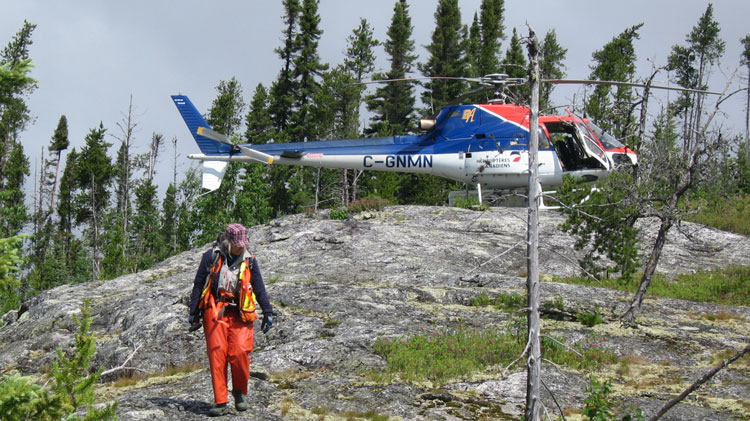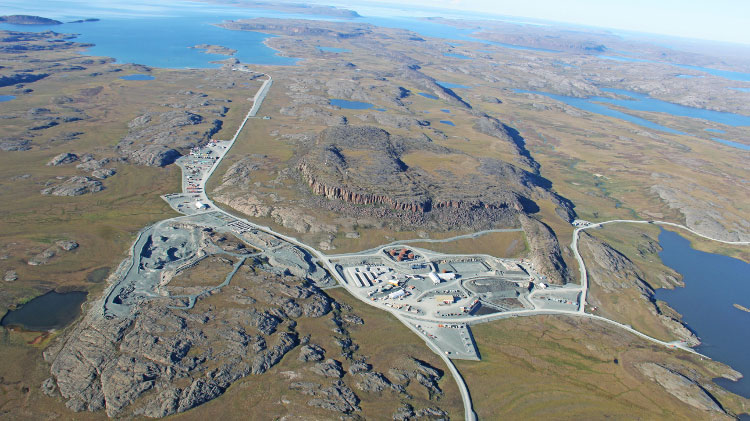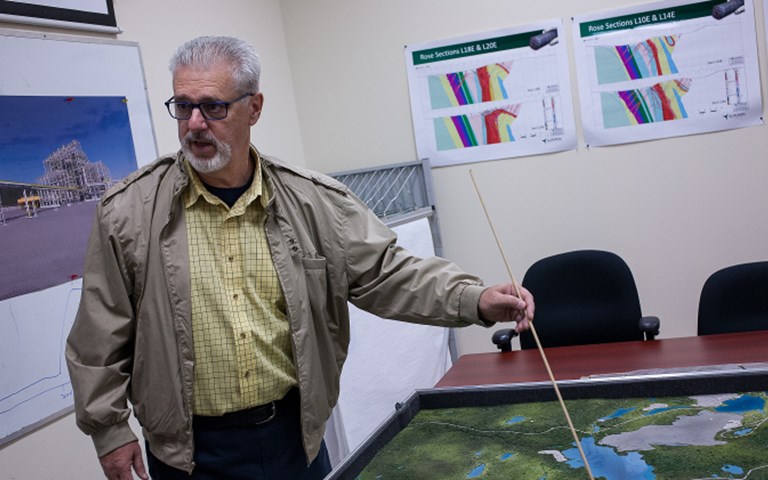Andy Robertson, Alderon’s general manager of human resources and community engagement, says the company will rely on its proximity to the labour pool in Labrador West and a packaged purchasing strategy to help keep capital and operating costs down. Valerian Mazataud
On the smooth hills that spread along the border between Quebec and Labrador, a patchwork of red, green and yellow shrubs grow from the burnt taiga. This is where Alderon Iron Ore hopes to soon start constructing its Kami mine, the most advanced development project in the iron-rich Labrador Trough.
A few years ago, when China’s steel mills were running at full capacity and the whole world was experiencing an unprecedented iron rush, a number of projects were set up in the Labrador Trough in the hopes of grabbing a piece of the action. The price for a tonne of iron ore, which until 2004 had for years not popped above US$17, suddenly skyrocketed in 2011 to nearly US$190.
Nearly four years later, things have changed. Many of the projects constructed during the iron rush have entered production and big players such as Rio Tinto, BHP Billiton and Vale have flooded the global market with supply, pulling prices down to the US$80 per tonne range and pushing minor players to the sidelines. In the Labrador Trough, development projects are working hard to raise financing.
Among these, Alderon Iron Ore’s Kami project is the furthest along. “Within the next few years or so, Alderon will be the one most likely to go ahead,” says Jackie Przybylowski, vicepresident and analyst of metals and mining at Desjardins Securities. Alderon filed its feasibility study in January 2013 and is currently striving to conclude financing before it can start construction. “We are working on the debt portion right now,” says Tayfun Eldem, president and CEO at Alderon. “Once we raise the debt, we will go to the equity market. From the time we are fully financed and board-sanctioned, it will take us about 26 months to construct.” Management is targeting a 70 per cent debt and 30 per cent equity mix in its financing efforts.
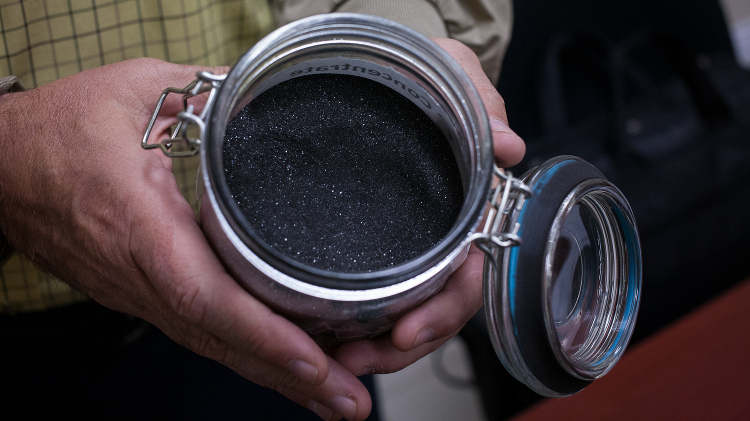 Robertson shows off a sample of the iron ore concentrate generated from the Kami project. Valerian Mazataud
Robertson shows off a sample of the iron ore concentrate generated from the Kami project. Valerian Mazataud
Putting the puzzle together
Beyond its ore deposit, the Kami project has a number of important assets, the first one being its location. “One of our greatest advantages is that we are close to the existing infrastructure for rail and power,” says Eldem. “We don’t have to build a large rail line to connect to the transportation network; it is only 14.5 kilometres away. As for power, we are about 15 km away from the main high-voltage power grid [in Labrador West].”
While Alderon took part in the CN’s feasibility study for a new rail line from Labrador City to Sept-Îles, Quebec, in August 2012, it has always based its projections on using the existing Iron Ore Company of Canada-owned QNS&L railway which runs north-south between Labrador City and the port of Sept-Îles. So it was not disappointed when CN decided to cancel the study in February 2013. “The QNS&L will be accommodating our tonnage because it has an obligation as a common carrier,” says Eldem. “Once we advance the project to a point where we are about a year before production, we will conclude an agreement.”
Not all companies might have this chance. “QNS&L still has some capacity left on its rail line,” says Nochane Rousseau, mining industry group leader for Quebec at Pricewaterhouse- Coopers Canada. “But will it be able to accommodate all of the projects that are coming in the Trough? No.” Kami’s timing enables it to secure its share of the carrier’s remaining capacity. QNS&L has the ability to add 45 Mt to the current 35 Mt from IOC, Cliffs, and Labrador Iron Mines.
As for power, Eldem calls the construction of a third transmission line – from Churchill Falls to Labrador West by Nalcor Energy – “critical” to the feasibility of the project. “For us, it secures 62 megawatts to power up our initial operations,” he says. Kami will provide up to $65 million in security deposits, which will be released back to it once the line starts supplying the project. The first security deposit of $21 million was paid last February, and Nalcor has already cleared 20 km of land. But work on the 240-km line will progress only as long as Kami can provide the remaining $44 million in security deposits. Nalcor suspended work on Oct. 2 due to delays in the Kami project’s financing.
The last piece of the puzzle is the new multi-user dock at the port of Sept-Îles, in which Kami has claimed its place. This $220-million project, launched in 2012 in the wake of the Plan Nord, will add 50 Mt to 60 Mt to the port’s capacity; Alderon has claimed an 8 Mt piece of that new capacity. Mining companies were asked to contribute to the financing to secure their share. “Our port access is guaranteed, along with three other mining companies,” says Eldem. “We have contributed $20.5 million towards construction, as a buy-in payment. We will recover our initial capital injection when we start shipping, because we will be getting a discount like the other users who have contributed towards construction.”
Making friends
All of this, though, would mean little if Kami was not sure of where to sell its 8 Mt of iron ore fines. In 2012 Hebei Iron and Steel Group, China’s largest steel producer, strategically invested more than US$180 million for a near 20 per cent share in Alderon and a 25 per cent share in Kami itself. In return, the steelmaker committed to buy 60 per cent of Kami’s total output, with a five per cent discount. According to a statement from the Chinese steelmaker when it made the deal, the investment was sound because Alderon offered one of the few, “high-quality, late development-stage iron ore projects” in a buyers’ market. Last July Alderon signed another off-take agreement to sell the remaining 40 per cent of its production to Glencore, with a two per cent discount. “With Glencore now on board, we are fully sold out,” said Eldem. “When we go into operation, we will automatically have a revenue stream from these two long-term contracts.”
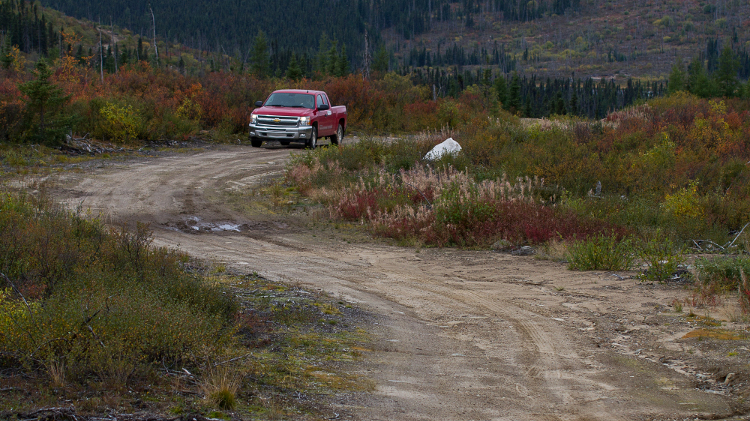 The property's proximity to other operations gives it the benefit of easy access to existing infrastructure. Valerian Mazataud
The property's proximity to other operations gives it the benefit of easy access to existing infrastructure. Valerian Mazataud
Now, with iron ore fines prices flirting with US$80 per tonne, it was critical to limit capital expenses and overall production costs. In such a competitive environment, productivity is clearly the name of the game. “We are aiming at a US$43 per tonne freight on board production cost,” says Andy Robertson, general manager of human resources and community engagement at Alderon, as he walked through the burned taiga covering Alderon’s property. “In order to accomplish that, we have learned lessons from past experiences in the Trough.” Last June Alderon signed a package deal agreement with Metso for the supplying of most of its equipment. “The way to limit capital expenses is by bundling as much of a package as possible,” says Eldem. “The agreement with Metso is a great example of it. Our AG mill, our ball mill, our gyratory crusher, and our railcar dumper will all come from Metso.”
Speed up or slow down?
With industry estimates for iron ore fines staying below US$100 per tonne in the coming years, many projects in the Trough could decide to wait for better days. “They won’t be executing their plans in the way they hoped to,” admits Przybylowski. “Raising financing in this environment will be challenging.” Even Alderon is already taking longer than she had expected.
So why not simply put the project on hold? “We take a long-term view of iron ore prices,” says Eldem. “We are at a downpoint of this saw-toothed profile that we have seen lately in iron ore prices. Keep in mind that it will take us two to 2.5 years to complete construction and begin operation. If you are going to do a project, taking your foot off the gas while the market is down limits your ability to catch the upside.”
There are obvious benefits to staying the course when the others are falling by the wayside. Equipment suppliers, service providers and the whole construction industry have cooled down since the overheated days of 2011, when both ArcelorMittal and IOC were launching their expansion projects. In addition, with the idling of operations at both Labrador Iron mines and Wabush mines, labour is not as much of an issue as it was three years ago, when hundreds of workers had to be flown in and accommodated in new camps. “The benefit for projects going ahead is that there will be less competition for port and rail infrastructures, and for labour, so the projects which do proceed should be more attractive in terms of the economics,” says Przybylowski.
In this context, the closeness to Labrador West and its 10,300 residents is priceless for Alderon. “Labrador West was built to support the mining operations in the region, so there is a wealth of mining knowledge and there is a strong support network in place,” says Eldem. “You have a number of equipment manufacturers, technical personnel, repair shops and warehouses in the region.”
As for labour itself, Alderon clearly favours local labour over non-residents flying in and out. “If you have a shovel breaking down at 2 a.m., you need your specialist around, not in Montreal,” says Robertson. “You don’t want to wait for eight hours to fix it.” Depending on whether Wabush mines resumes operations, housing may even be available already.
“We believe in a residential employment model. It’s less expensive and it promotes ownership for employees,” says Eldem. “They commit to the community, and they support the business.” With access to port, rail, power, clients and labour already well in hand, many are watching to see when and how the company will play its cards.
